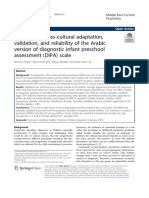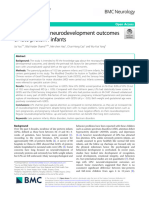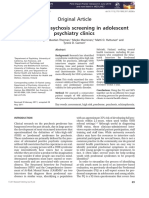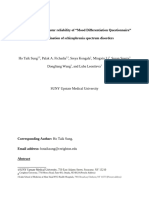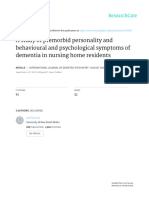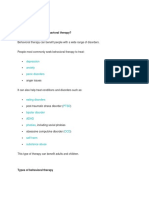Psychometric Properties of Conversion Disorder Scale-Revised (CDS) For Children
Psychometric Properties of Conversion Disorder Scale-Revised (CDS) For Children
Uploaded by
Asif BalochCopyright:
Available Formats
Psychometric Properties of Conversion Disorder Scale-Revised (CDS) For Children
Psychometric Properties of Conversion Disorder Scale-Revised (CDS) For Children
Uploaded by
Asif BalochOriginal Description:
Original Title
Copyright
Available Formats
Share this document
Did you find this document useful?
Is this content inappropriate?
Copyright:
Available Formats
Psychometric Properties of Conversion Disorder Scale-Revised (CDS) For Children
Psychometric Properties of Conversion Disorder Scale-Revised (CDS) For Children
Uploaded by
Asif BalochCopyright:
Available Formats
725
ORIGINAL ARTICLE
Psychometric properties of Conversion Disorder Scale- Revised (CDS) for children
Tazvin Ijaz,1 Attikah Nasir,2 Naema Sarfraz,3 Shirmeen Ijaz4
Abstract
Objective: To revise conversion disorder scale and to establish the psychometric properties of the revised scale.
Methods: This case-control study was conducted from February to June, 2014, at the Government College
University, Lahore, Pakistan, and comprised schoolchildren and children with conversion disorder. In order to
generate items for revised version of conversion disorder scale, seven practising mental health professionals were
consulted. A list of 42 items was finalised for expert ratings. After empirical validation, a scale of 40 items was
administered on the participants and factor analysis was conducted.
Results: Of the240 participants, 120(50%) were schoolchildren (controls group) and 120(50%)were children with
conversion disorder (clinical group).The results of factor analysis revealed five factors (swallowing and speech
symptoms, motor symptoms, sensory symptoms, weakness and fatigue, and mixed symptoms) and retention of all
40 items of revised version of conversion disorder scale. Concurrent validity of the revised scale was found to be 0.81
groups had significant difference (p<0.001) in scores. Cronbach's alpha of scale was α=0.91 while item total
which was significantly high. Similarly, discriminant validity of the scale was also high as both clinical and control
correlation ranged from 0.50 to 0.80. The sensitivity and specificity analysis indicated that the revised conversion
disorder scale was 76% sensitive to predicting conversion disorder while specificity showed that the scale was 73%
accurate in specifying participants of the control group.
Conclusion: The revised version of conversion disorder scale was a reliable and valid tool to be used for screening
of children with conversion disorder.
Keywords: Children, Conversion, Stressors. (JPMA 67: 725; 2017)
Introduction in Asian countries, particularly Pakistan, in the previous
For the growth of any country, there is a need to focus on few years.2 In a country where the basic needs of
the physical and mental well-being of our children and population are not met, provision of mental health
youth. Pakistan as a developing country needs the effort facilities is a far-fetched idea.
and hard work of our youth to become a prosperous
Conversion disorder is named as Functional Neurological
nation. With reference to Pakistani culture, the study of
Symptom Disorder in Diagnostic and Statistical Manual of
somatic symptoms and related disorders, particularly
Mental Disorders, 5th edition (DSM-V).3 The disorder was
conversion disorder, is needed because in our culture
there is a tendency to accept physiological symptoms previously considered as one of the somatoform
more readily as compared to psychological symptoms. disorders, but in DSM-V it is categorised under the domain
Research conducted by Tomb and David (1995)1 showed of somatic symptom and related disorders.
that in countries like Pakistan, there are biased attitudes The manifestation of conversion disorder is influenced by
towards mental health problems and these socio-cultural culture as it affects the way a child's problem is treated by
inhibitions are the most important factors that lead to lack the parents. Culture also shapes the benefits and gains in
of proper attention and promote emotional and children generally associated with conversion disorder.4
psychological disorders. In addition, culture also has significant impact on
In Pakistani society the cultural acceptance for physical incidence rate and aetiological factors of conversion
symptoms and high chances of medical consultation disorder so it is very important to study these domains,
increased the probability of channelising distress in the specifically in Pakistani culture.
form of dissociation and conversion disorder. This could
Researches conducted on conversion disorder in both
be a reason of high incidence rate of conversion disorder
Western and non-Western countries agreed on the
findings that conversion disorder is more common in
1-3Clinical Psychology Unit, GC University, 4Lahore College for Women those cultures that consider conversion symptoms
University, Lahore. acceptable rather than bizarre,5 and its incidence rate is
Correspondence: Tazvin Ijaz. Email: tazvinijaz@gcu.edu.pk primarily high in those societies which have strict and
J Pak Med Assoc
Psychometric properties of Conversion Disorder Scale- Revised (CDS) for children 726
conservative social systems that inhibit individuals from In order to generate items for revised version of CDS,
directly expressing their emotions and feelings towards seven practising mental health professionals were
others.6 interviewed and were asked to report items on the basis
of their clinical experience. At the end of this phase, all the
Regarding symptom pattern of conversion disorder, items identified by experts were reviewed by two senior
Western studies indicated that somatic complaints, i.e. researchers and a list of 42 items was finalised for expert
headache and lower back pain, were most frequently ratings after excluding overlapping items.
reported symptoms of conversion disorder.7 While few
researches conducted on conversion symptoms in During this phase, the list of 42 items was given to experts
Pakistani culture showed that manifestation of disorder in for empirical validation. In order to get ratings from
developing countries is different from Western countries experts, seven practising clinical psychologists were
as approximately one-third to one half patients selected who rated each symptom on the basis of degree
consulting psychiatric units here present with motor to which it reflects conversion symptoms. Clinical
symptoms.8 A study9 reported that unresponsiveness and psychologists having three years of experience in child
tremors (jerky movements) are the most common psychiatry were selected as experts. Experts were
presenting symptoms of conversion disorder. In Pakistani, provided with instructions to rate the list of items on the
culture conversion disorder is usually co-morbid with basis of degree to which each symptom is characteristic of
anxiety and depressive symptoms.9 conversion disorder in the Pakistani society. They were
asked to rate these items on a four-point rating scale from
The cultural impact on symptom presentation and other 0 to 3 where 0 means that symptom is not representative
important domains of conversion disorder highlights the of conversion disorder, 1= a little bit representative, 2=
importance of indigenously developed and culturally somewhat representative, and 3= representative of
valid and reliable scale so that conversion could be conversion disorder most of the time. After getting expert
understood in Pakistani cultural perspective. In order to ratings, a league table of items was developed
understand cultural aspects of conversion disorders a representing the degree of agreement among experts on
study10 developed an indigenous conversion disorder each item. Items with 70% or above percentage of
scale (CDS)for children. agreement were retained. After eliminating low-rating
items, a list of 40 items was retained, which were
The indigenous CDS scale10 was based on the DSM-IV tax transformed into three-point rating scale, i.e. 0 = not at all,
revision (TR) criteria but due to recent modification in 1= sometimes and 2= most of the time.
DSM-V criteria of conversion disorder there is a need to
revise the CDS. The revision of scale is essential in order to This phase of research was conducted to establish the
overcome the scarcity of up-to-date indigenously psychometric properties of revised CDS version (CDS-R).
developed tools of conversion disorder. The current study The sample for the study consisted of children school
was conducted to update CDS according to DSM-V criteria children as the control group and children with
of conversion disorder and to establish the psychometric conversion disorder as the clinical group.
properties of it. The revised version will be more culturally
Simple random sampling was used to get data from the
reflective and fulfilling the current criteria of conversion
schoolchildren. One boys' school and one girls' school
disorder so it will be very beneficial to understand was selected for data collection. Students of grade 6th,
conversion disorder among children in Pakistan. 7th, 8th and 9th were included in the study. Purposive
Subjects and Methods sampling was used with conversion patients. Only those
patients who were diagnosed by the clinical psychologist
The study was conducted from February to June, 2014, at
of the hospital according to the DSMV criteria were
the Government College (GC) University, Lahore, Pakistan,
included.
and comprised schoolchildren and children with
conversion disorder. In order to elicit symptoms, DSM-V The Children Somatisation Inventory (CSI) was developed
criteria of conversion disorder was consulted and seven and revised in 2009.11 The revised version of CSI consists
practising mental health professionals including four of 24 self-reported items which measure the extent to
clinical psychologists, two psychiatrists and one which a child has experienced these symptoms in the
neurologist were interviewed by using semi-structured preceding two weeks. The items are rated on a five-point
interviews. Mental health professionals with at least three rating scale, with 0 = not at all, 1 = a little, 2 = some, 3 = a
version of CSI was α = 0.85 and that of Urdu version was α
years of experience in child psychiatry were included in lot, and 4 = a whole lot. The Cronbach's alpha of English
the sample for interview.
Vol. 67, No. 5, May 2017
727 T. Ijaz, A. Nasir, N. Sarfraz, et al
= 0.83 which showed Urdu version is reliable in Pakistani subscales were calculated. It was found that reliability of
culture. all five factors was in the range of 0.61 to 0.85 which was
significantly high. The reliability of total score of CDS-R
CDS is an indigenous scale10 for screening conversion was 0.91 which was also significantly high. The high alpha
disorder in children in Pakistani culture. The scale reliability of CDS-R shows that scale was highly internally
consisted of 19 items. CDS-R consisted of 40 items and consistent.
these items were rated on a three-point rating scale, i.e. 0
= not at all, 1 = sometimes and 2 = most of the time. In order to find concurrent validity of CDS-R, Urdu version
of a standardised scale of somatisation, i.e. CSI-24,11 was
In order to get data from hospitals, permissions were used. The correlation between two scales was found to be
taken from concerned authorities. Participants were then 0.81 which was significantly high.
approached for data collection. Informed consent was
taken from parents or elder siblings of children. In The discriminant validity of CDS-R was calculated by
addition, the purpose of the present research was fully comparing control and clinical groups. Independent
explained to participants. The scale was individually sample t-test was used for comparing scores of both
administered on participants. In order to find discriminant groups (Table-1).
validity, Urdu versions of CSI-24 and CDS-R were
There was a significant difference between the scores of
administered on the schoolchildren after getting
control and conversion groups. On average, conversion
permission from administration of government higher
patients scored high on CDS-R as compared to the control
secondary schools for boys and girls. Students from
group. The significant difference between scores of both
classes 6th, 7th, 8th and 9th were selected through
groups indicated that CDS-R had high discriminant
random selection. It was a group administration. Consent
validity.
was taken from students and they were ensured about
confidentiality of provided information. The split half reliability of the CDS-R was calculated by
dividing the scale of 40 items into two equal halves of
Results 20(50%) items each. The reliability of the first half of scale
There were 240 children in the study, including 120(50%) was found to be 0.83 and the reliability of its second half
schoolchildren and 120(50%) children with conversion was calculated to be 0.86 which showed that both parts of
disorder. Of the schoolchildren, 60(50%) were boys and CDS-R were equally reliable.
60(50%) were girls. The mean age in the clinical group was
13.25±2.47 years and in the control group it was The data obtained from conversion disorder patients was
13.15±1.38 years. analysed to identify the percentile scores and their
suggested category. These values were important to
In order to explore the factorial structure of CDS-R, interpret the scores obtained on CDS-R and identify the
exploratory factor analysis, principal component method severity level of conversion symptoms of an individual
with varimax rotation was used. The criteria to retain (Table-2).
factors were scree plot, eigen value of > 1 and factor
loading of >0.40. The scree plot revealed five factors for The sensitivity of a clinical test refers to "the ability of the
CDS-R. At the end, five factors solution was retained as it test to correctly identify those patients with the disease"
gives a clear distinction of items. while specificity could be described as "ability of the test
to correctly identify those patients without the disease".12
Five factors among the total 40 items were identified. All
40 items were retained on five-factor loading. The 1st In order to find sensitivity and specificity of CDS-R, the
factor 'swallowing and speech symptoms' consisted of concept of true and false positive and true and false
10(25%) items and had highest amount of variance. This negative was used, i.e. participants of both clinical and
was followed by 2nd factor 'motor symptoms' that control groups who had cut-off CDS-R score of less than or
included 9(22.5%) items. Factor 3 'sensory symptoms' and above 19 were considered. The results of the sensitivity
factor 4 'weakness and fatigue' consisted of 8(20%) items analysis showed that CDS-R correctly screened out
each while the 5th factor 'mixed symptoms' comprised 91(76%) patients while 29(24%) patients had scores less
5(12.5%) items in total. Eigen value of all the five factors than cut-off of CDS-R as they had very mild symptoms of
was more than 1 which implies a high degree of variance conversion disorder. Similarly, specificity analysis showed
in the scale. that 88(73%) participants of the control group were
correctly reported as without conversion disorder while
Cronbach's alpha of total score of CDS-R and its five 32(27%) had scores above the cut-off of CDS-R showing
J Pak Med Assoc
Psychometric properties of Conversion Disorder Scale- Revised (CDS) for children 728
Table-1: Factor Loadings, Eigen Values and Cronbach Alpha for Exploratory Factor Analysis with Varimax Rotation of Conversion Disorder Scale-R (factor loading > .40).
Sr. No. Item No. Items Factor 1 Factor 2 Factor 3 Factor 4 Factor 5
1 3 Speaking with coughing 0.48 0.01 0.03 -0.00 0.52
2 9 Change of voice 0.52 0.11 0.23 0.24 0.10
3 11 Coughing 0.49 -0.03 -0.10 0.09 0.49
4 20 Difficulty in breathing 0.70 0.02 0.12 0.28 0.08
5 22 Depletion of voice 0.54 0.15 0.11 0.29 -0.11
6 25 Lump in throat 0.66 0.25 0.04 -0.12 0.15
7 30 Difficulty in speaking 0.58 0.16 0.18 0.32 0.15
8 35 Difficulty in swallowing 0.73 0.04 0.10 -0.14 0.12
9 36 Rapid breathing 0.56 0.23 0.17 0.09 0.02
10 37 Stretch during speaking 0.73 0.12 0.12 0.07 0.10
11 7 Immobility of one or more body parts 0.29 0.49 0.36 0.13 0.27
12 23 Lying on floor during fits -0.06 0.41 0.02 0.12 0.46
13 24 Inability to move hand 0.12 0.54 0.22 0.31 -0.08
14 26 Extra-sensory perceptions 0.14 0.65 0.12 -0.02 -0.00
15 31 Paralysis 0.11 0.50 0.03 0.31 0.41
16 32 Partial/complete seizures 0.04 0.51 0.33 0.10 0.10
17 34 Inability to listen during fits 0.05 0.62 0.07 -0.03 0.20
18 39 Blindness 0.24 0.57 -0.06 0.23 0.06
19 40 Perception of being possessed 0.11 0.63 0.12 -0.10 -0.17
20 1 Pain in legs and foot 0.07 0.03 0.60 0.23 -0.00
21 2 Cramp in hands and foot 0.17 0.22 0.49 -0.17 0.26
22 5 Feeling stretching in body 0.05 0.05 0.60 0.17 0.17
23 13 Tingling sensation in body 0.15 0.00 0.63 0.17 0.06
24 19 Body stiffness 0.15 0.28 0.66 -0.08 0.11
25 21 Pain in hands and arms 0.30 0.11 0.55 0.18 0.18
26 33 Difficulty in walking 0.16 0.45 0.42 0.27 -0.13
27 38 Numbness of body organs 0.13 0.34 0.52 0.15 -0.08
28 6 Headache -0.11 -0.15 0.12 0.59 0.15
29 12 Pale skin colour 0.31 0.14 0.23 0.43 -0.00
30 14 Difficulty in maintaining balance while walking 0.27 0.13 0.13 0.56 -0.31
31 16 Pain in eyes 0.12 0.07 0.17 0.62 0.18
32 17 Dizziness -0.08 0.17 0.03 0.71 0.10
33 27 Blurred vision 0.20 0.38 -0.02 0.53 0.06
34 28 Weakness 0.02 0.08 0.40 0.41 0.09
35 29 Sleepy or heavy feelings in head 0.14 0.07 0.23 0.67 0.17
36 4 Pain in stomach 0.11 -0.01 0.22 0.04 0.51
37 8 Faintness -0.14 0.56 0.07 0.24 0.43
38 10 Pain in chest 0.34 -0.03 0.20 0.12 0.51
39 15 Vomiting 0.15 0.23 0.07 0.09 0.42
40 18 Severe backache 0.03 0.02 0.39 0.18 0.44
Eigen Values 4.62 4.06 3.70 3.70 2.67
% of Variance 11.56 10.15 9.26 9.25 6.68
Cumulative Variance 11.56 21.71 30.97 40.22 46.91
Note. Factor loadings >0.40 are in boldface.
Table-2: Mean, SD and t-value of Control Group and Clinical Group on CDS-R (N = 240).
Scale Groups M SD t(238) p
CDS-R Clinical group 34.05 15.51 10.55 0.001***
Control group 16.21 10.11
***p < .001
CDS-R: Revised version of conversion disorder scale
M: Mean. SD: Standard deviation.
Vol. 67, No. 5, May 2017
729 T. Ijaz, A. Nasir, N. Sarfraz, et al
Table-3: CDS-R Scores, Percentile and their Category (N = 120). conversion disorder patients in Pakistan.8,15 The relative
more importance of motor symptoms of conversion
CDS-R Score Percentile Category
disorder in countries like Pakistan could be due to cultural
1 - 19 25 Mild Conversion Symptoms
acceptance of this expression of emotional distress.16
20 - 34 50 Moderate Conversion Symptoms Since convulsions or seizures are generally considered as
35 - 47 75 Severe Conversion Symptoms life-threatening, an individual with this manifestation
48 - 80 100 Very Severe Conversion Symptoms could easily attract attention of others.17
CDS-R: Revised version of conversion disorder scale.
The second factor also contains items that are related to
sensory perceptions, e.g. extra-sensory perceptions,
some symptoms of conversion disorder (Table-3). perception of being possessed, etc. In our culture, these
symptoms are usually considered as part of some
Discussion culturally authorised religious and spiritual practices as
Conversion disorder is one of most frequently reported one study17 also reported that possession and other such
psychiatric problems in our culture as it accounts for symptoms are fourth-most common reported symptoms
12.4% admissions in psychiatric in-patients of Pakistan.13 in India.
One of important reasons of this gradual increase in the
incidence rate of conversion disorder is our cultural The third factor comprises of sensory symptoms of
practice of accepting physical symptoms instead of conversion disorder including anaesthesia or sensory loss
psychological problems.2 In addition, culture also and pain. The presence of this domain after convulsion or
influences the manifestation of conversion disorder, seizure symptoms of conversion disorder was in line with
therefore, to fully understand cultural-based symptoms of a study.18 The quite high significance of sensory
conversion disorder there is a need of indigenously symptoms in our society could be particularly associated
developed and culturally valid and reliable scale. with secondary gain of relief from work as most of the
patients with these symptoms discontinue their routine
The factor analysis conducted on CDS-R revealed five tasks.2 Moreover, due to a lack of accurate understanding
factors, i.e. swallowing and speech symptoms, motor of nature of conversion disorder, most of the people
symptoms, sensory symptoms, weakness and fatigue and considered sensory loss as an indicator of severe
mixed symptoms. The first factor consists of swallowing underlying medical problems so these symptoms are
and speech-based symptoms of conversion disorder, e.g. quite frequently brought into clinical attention.
difficulty in swallowing, lump in throat, difficulty in
speaking, speaking with coughing, change of voice, etc. The fourth factor consists of weakness and fatigue based
This factor appears to be most significant factor as it symptoms of conversion disorder, e.g. pale skin colour,
consists of most important symptoms reported by the difficulty in maintaining balance while walking, dizziness,
participants of clinical group. blurred vision, weakness and sleepy or heavy feelings in
head. This factor did not receive much attention in
This finding is contradictory to findings of previous previous studies on conversion disorder.19 Contrary to
researches. The accurate reason of this contradiction this, in Pakistani culture there is a common practice of
between previous indigenous and foreign studies is not giving considerable importance to the symptoms of
very clear, but there are several possibilities. One fatigue and weakness either associated with conversion
important assumption of this difference in symptom is disorder or with any other problem.
"current health concerns of the particular culture".14
Therefore, it could be assumed that the major concern of The fifth factor is based on mixed symptoms category of
conversion disorder patients of the current study was conversion disorder, e.g. pain in stomach, faintness, pain
swallowing and speech-related problems, but this in chest, vomiting and severe backache. This is the least
concern could change with the passage of time. important factor, possibly due to the combination of
different physical complaints that are not specifically
The second most significant factor revealed by factor associated with conversion disorder.
analysis is related to motor symptoms of conversion
disorder including seizures, immobility and abnormal Overall, factor analysis of CDS-R revealed some similarities
movement. The emergence of this factor as second most and some differences with previous Western studies and
significant factor was in accordance with findings of indigenous studies. The more significance of swallowing
previous researches which concluded that motor and speech symptoms and items related to extra-sensory
symptoms are most common symptom reported by perceptions and possession are culturally unique items,
J Pak Med Assoc
Psychometric properties of Conversion Disorder Scale- Revised (CDS) for children 730
but items of other domains i.e. motor, sensory, mixed, are patients with motor disability due to conversion disorder: A
equally important in Pakistani culture. prospective control group study. J Neurology Neuro Psych.1997;
63:83-8.
8. Khan S, Ladha A, Khan SK, Khan SF, Malik AA, Memon Z, et al.
Conclusion Presentation and features of conversion disorder at a tertiary care
Most significant symptoms of conversion disorder in our hospital in Karachi. Pak J Neuro Sci. 2006; 1: 128-31.
culture were swallowing and speech-related symptoms. 9. Chaudhry HR, Arshad N, Niaz S, Cheema FA, Iqbal MM, Mufti KA.
Inspite of increased awareness regarding conversion Fifteen-year follow-up of conversion disorder. Inter Psych. 2005; 2:
17-9.
disorder, symptoms related to possession and extra
10. Sarfraz N, Ijaz T. Development of Conversion Disorder Scale for
sensory perception are equally prevailed here, therefore, children. J Behav Sci. 2014; 24: 44-56.
the present study can serve the purpose of understanding 11. Walker LS, BeckJE, Garber J, Lambert W. Children's Somatization
conversion disorder in cultural context with a revised and Inventory: Psychometric properties of the revised form (CSI-24). J
up-to-date screening tool. Pedia psycho. 2009; 34: 430-40.
12. Lalkhen AG, McCluskey A. Clinical Tests: sensitivity and specificity.
Disclaimer: None. British J Anest. 2008; 8: 221-3.
13. Farooq S. Conversion disorder-A dilemma facing the psychiatrist
Conflict of Interest: None. in developing countries. J Pak Psy Soc. 2007; 4: 60-2.
14. Brown RJ, Lewis-Fernández R. Culture and conversion disorder:
Source of Funding: None. Implications for DSM-5. Psychiatry: Inter Bio Pro. 2011; 74: 187-
206.
References 15. Syed, E. U., Atiq, R., Effendi S, & Mehmud, S. Conversion disorder:
1. Tomb, David A. eds. Hysteria. (5th ed). New York, USA: Williams & Difficulties in diagnosing using DSM-IV/ICD-10. J Pak Med Assoc.
Wilkins,1995. 2001; 51: 143-5.
2. Aamir S. Stressful life events in the onset of Dissociative 16. Srinath S, Bharat S, Girimaji S, Seshadri S. Characteristics of a child
(Conversion) disorders. J Pak Psych Soc. 2005; 2: 65-8. inpatient population with hysteria in India. J Amer Acad Child
3. Diagnostic and Statistical Manual of Mental Disorders. Adoles Psy. 1993; 32: 822-5.
5thed.Washington, DC:American Psychiatric Association, 2013. 17. Prabhuswamy M, Jairam R, Srinath S, Girimaji S, Seshadri S P. A
4. Eminson DM. Somatising in children and adolescents. 1. Clinical systematic chart review of inpatient population with childhood
presentations and aetiological factors. Adv Psych Treat. 2001; 7: dissociative disorder. J Indian Assoc Child Adoles Mental Health.
266-74. 2006; 2: 72-7.
5. Diagnostic and Statistical Manual of Mental Disorders. 4th ed. 18. Abbas A, Hussain M I, Busri R, Shah M. Association of depression
Washington, DC: American Psychiatric Association, 1994. with dissociative convulsions. Khyber J Med Sci. 2014; 7: 62-5.
6. Al-Maghrabi, Hafiez HB, El-Sayed SM. Hyterical pattern in eastern 19. Sharma I, Giri D, Dutta A, Mazumder P. Psychosocial factors in
Saudi Arabia. Ann Saudi Med. 1988; 3: 461-5. children and adolescents with conversion disorder. JIndian Assoc
7. Binzer M, Andersen PM, Kullgren G. Clinical characteristics of Child Adoles Mental Health. 2005; 1: 3-7.
Vol. 67, No. 5, May 2017
You might also like
- F20 Schizophrenia Case StudyDocument45 pagesF20 Schizophrenia Case StudyRichard Joseph DomingoNo ratings yet
- The Thematic Apperception TestDocument1 pageThe Thematic Apperception TestShibu ShankarNo ratings yet
- Shaker2020 Article TranslationCross-culturalAdaptDocument7 pagesShaker2020 Article TranslationCross-culturalAdaptwishfairy67No ratings yet
- Developmental Psychopathology ChecklistDocument5 pagesDevelopmental Psychopathology ChecklistHimani100% (2)
- Developmental Psychopathology Check List For Children DPCL A Preliminary Report 1 9Document8 pagesDevelopmental Psychopathology Check List For Children DPCL A Preliminary Report 1 9triashaNo ratings yet
- Behavior profile of children with nephrotic syndromeDocument6 pagesBehavior profile of children with nephrotic syndromeShubham ChauhanNo ratings yet
- editor,+6-523-P-147-153_compressed-2Document7 pageseditor,+6-523-P-147-153_compressed-2channahhaniyaNo ratings yet
- Health-Related Quality of Life in Children With CeDocument4 pagesHealth-Related Quality of Life in Children With CepkalikinkarojhaNo ratings yet
- 1 s2.0 S0010440X15302169 MainDocument4 pages1 s2.0 S0010440X15302169 Mainlidia torres rosadoNo ratings yet
- 2470 PDFDocument8 pages2470 PDFPreetha Kumar AJKKNo ratings yet
- Esquizofrenia Infantil Guia IAACAPDocument15 pagesEsquizofrenia Infantil Guia IAACAPAdolfo Lara RdzNo ratings yet
- Perceived Childhood Paternal Acceptance-Rejection Among AdultsDocument3 pagesPerceived Childhood Paternal Acceptance-Rejection Among AdultsewrerwrewNo ratings yet
- Emotional and Behavioural Problems in Young Children With Autism Spectrum DisorderDocument7 pagesEmotional and Behavioural Problems in Young Children With Autism Spectrum DisorderagalbimaNo ratings yet
- Cognitive Emotion Regulation Questionnaire - Development of A Short 18-Item Version (CERQ-short)Document9 pagesCognitive Emotion Regulation Questionnaire - Development of A Short 18-Item Version (CERQ-short)leonardNo ratings yet
- Papers Sds JournalDocument18 pagesPapers Sds Journalfatimasaeed2772No ratings yet
- Baseline 2019 PaperDocument35 pagesBaseline 2019 PaperEva Nor AfifahNo ratings yet
- Original Article Psychological Status And: Coping Strategy of Somatization DisordersDocument5 pagesOriginal Article Psychological Status And: Coping Strategy of Somatization DisordersityNo ratings yet
- Akuads PDFDocument9 pagesAkuads PDFFaruqi FarisNo ratings yet
- Undifferentiated SchizophreniaDocument190 pagesUndifferentiated Schizophreniaallexiscampaner100% (17)
- Evidence For Early-Childhood, Pan-Developmental Impairment Specific To Schizophreniform DisorderDocument8 pagesEvidence For Early-Childhood, Pan-Developmental Impairment Specific To Schizophreniform Disorderyeremias setyawanNo ratings yet
- Efficacy-of-culturally-adapted-interventions-for-cDocument15 pagesEfficacy-of-culturally-adapted-interventions-for-cfybfnyj78kNo ratings yet
- The Dissociative Experiences Scale: An Urdu Translation: Christopher Alan Lewis: Department of Psychology, Institute ForDocument5 pagesThe Dissociative Experiences Scale: An Urdu Translation: Christopher Alan Lewis: Department of Psychology, Institute Forzaini100% (1)
- Schizophrenia Evaluation 1Document4 pagesSchizophrenia Evaluation 1hajarazam04No ratings yet
- andreasen1995SINTOMAS DE LA ESQUIZOFRENIADocument11 pagesandreasen1995SINTOMAS DE LA ESQUIZOFRENIAmarielaNo ratings yet
- REVISED FInalDocument41 pagesREVISED FInalJohn Lewis SuguitanNo ratings yet
- Cognitive Insight As An Indicator of Competence To Consent To Treatment in SchizophreniaDocument4 pagesCognitive Insight As An Indicator of Competence To Consent To Treatment in SchizophreniaJulio DelgadoNo ratings yet
- Feeny 2006 CBT For Bipolar Pilot 19719Document8 pagesFeeny 2006 CBT For Bipolar Pilot 19719shobaNo ratings yet
- The Prevalence and Pattern of Psychological Disturbance in School Going Middle Childhood ChildrenDocument8 pagesThe Prevalence and Pattern of Psychological Disturbance in School Going Middle Childhood ChildrenRakesh KumarNo ratings yet
- The Development and Validation of The Peradeniya Depression Scale (PDS) - A Culturally Relevant Tool For Screening of Depression in Sri LankaDocument7 pagesThe Development and Validation of The Peradeniya Depression Scale (PDS) - A Culturally Relevant Tool For Screening of Depression in Sri LankaDilshan SonnadaraNo ratings yet
- Role of Play Therapy in Childhood Grief: A Case Report: December 2016Document73 pagesRole of Play Therapy in Childhood Grief: A Case Report: December 2016Ram JayNo ratings yet
- Validation of Attention Deficit Hyperactivity DisoDocument5 pagesValidation of Attention Deficit Hyperactivity DisoNarmada DevkotaNo ratings yet
- 2019 Article 1336Document6 pages2019 Article 1336Eduardo LimaNo ratings yet
- Pediatric Transplant Rating InstrumentDocument10 pagesPediatric Transplant Rating InstrumentcoxalfonsoNo ratings yet
- Cuestionario Breve de Tamizaje y Diagnóstico Salud MentalDocument8 pagesCuestionario Breve de Tamizaje y Diagnóstico Salud Mentalmiguel angel geronimo floresNo ratings yet
- Recommended Measures For The Assessment of Behavioral Disturbances Associated With DementiaDocument13 pagesRecommended Measures For The Assessment of Behavioral Disturbances Associated With DementiaaureliasartikaNo ratings yet
- Lau 2021Document12 pagesLau 2021Kevin LunaNo ratings yet
- Townshend - Effectivness of Mindful Parents ProgramsDocument40 pagesTownshend - Effectivness of Mindful Parents ProgramsDavid ZNo ratings yet
- Epilepsy & Behavior: Shanna M. Guilfoyle, Sally Monahan, Cindy Wesolowski, Avani C. ModiDocument6 pagesEpilepsy & Behavior: Shanna M. Guilfoyle, Sally Monahan, Cindy Wesolowski, Avani C. ModiJhonny BatongNo ratings yet
- Cavendish Road State High SchoolDocument3 pagesCavendish Road State High SchoolCakesNo ratings yet
- Benefits of An Experimental Program of Equestrian Therapy For Children With ADHD PDFDocument10 pagesBenefits of An Experimental Program of Equestrian Therapy For Children With ADHD PDFJuli DeviaNo ratings yet
- Translation and Validation of Symptom Checklist-90: Nadia Shafique and Muhammad Tahir KhalilyDocument17 pagesTranslation and Validation of Symptom Checklist-90: Nadia Shafique and Muhammad Tahir Khalilyaneela khanNo ratings yet
- Mental Health Problems and Speech Development in Toddlers With Physical IllnessesDocument7 pagesMental Health Problems and Speech Development in Toddlers With Physical IllnessesIU TrezzaNo ratings yet
- Loewy2012 - Prodromal Psychosis Screening in Adolescent Psychiatry ClinicsDocument7 pagesLoewy2012 - Prodromal Psychosis Screening in Adolescent Psychiatry ClinicsLuz María Sánchez ANo ratings yet
- Feasibility and inter-rater reliability.Document30 pagesFeasibility and inter-rater reliability.hotaikNo ratings yet
- jamapsychiatry_osborn_2021_oi_210028_1628043324.91149 - 2025-01-04 14-32-00Document9 pagesjamapsychiatry_osborn_2021_oi_210028_1628043324.91149 - 2025-01-04 14-32-00shaimaa.refaatNo ratings yet
- Factor Structure of The Urdu Version of The Strengths and Difficulties Questionnaire in Pakistani AdolescentsDocument7 pagesFactor Structure of The Urdu Version of The Strengths and Difficulties Questionnaire in Pakistani AdolescentsSyed SaqibNo ratings yet
- Harker Washington 0250E 19146Document109 pagesHarker Washington 0250E 19146CHEE KOK SENGNo ratings yet
- Office-Based Motivational Interviewing To Prevent Childhood ObesityDocument7 pagesOffice-Based Motivational Interviewing To Prevent Childhood ObesitynicloverNo ratings yet
- A Study of Premorbid PersonalityDocument6 pagesA Study of Premorbid PersonalityLidia García FernándezNo ratings yet
- Diagnosis of Personality Disorder in AdolescentsDocument4 pagesDiagnosis of Personality Disorder in AdolescentsFlo RenceNo ratings yet
- Impact of Psychosis in Bipolar Disorder During Manic EpisodesDocument16 pagesImpact of Psychosis in Bipolar Disorder During Manic EpisodesAulia Putri NurilmaNo ratings yet
- Original Article Psychological Status And: Coping Strategy of Somatization DisordersDocument5 pagesOriginal Article Psychological Status And: Coping Strategy of Somatization DisordersityNo ratings yet
- Deavin-2018-Childrens-perspectives-on-living-wiDocument11 pagesDeavin-2018-Childrens-perspectives-on-living-wiPaolaCatNo ratings yet
- RCADS Clinical (Chorpita, Moffitt, Gray)Document14 pagesRCADS Clinical (Chorpita, Moffitt, Gray)Paula Maciel100% (1)
- Cross Cultural Adaptation of The ArabicDocument19 pagesCross Cultural Adaptation of The ArabicouaalayaNo ratings yet
- Navigating the Spectrum: A Comprehensive Treatise on Pediatric Bipolar DisorderFrom EverandNavigating the Spectrum: A Comprehensive Treatise on Pediatric Bipolar DisorderNo ratings yet
- Children of Divorced Parents: Assertiveness Training and Cognitive Restructuring Techniques in Increasing Self-Esteem of Female Adolescents from Divorced HomesFrom EverandChildren of Divorced Parents: Assertiveness Training and Cognitive Restructuring Techniques in Increasing Self-Esteem of Female Adolescents from Divorced HomesNo ratings yet
- Parent-Child Interaction Therapy with Toddlers: Improving Attachment and Emotion RegulationFrom EverandParent-Child Interaction Therapy with Toddlers: Improving Attachment and Emotion RegulationNo ratings yet
- The Handbook of Training and Practice in Infant and Preschool Mental HealthFrom EverandThe Handbook of Training and Practice in Infant and Preschool Mental HealthKaren Moran FinelloNo ratings yet
- DeRomanis FAQs 1Document5 pagesDeRomanis FAQs 1alópez_199227No ratings yet
- Bimtek VTS Bekasi PDFDocument1 pageBimtek VTS Bekasi PDFApapunadadisini JugaNo ratings yet
- Cidam Oral CommDocument5 pagesCidam Oral CommHarlene Marikit AsendidoNo ratings yet
- TP Task 1 1Document4 pagesTP Task 1 1api-307396832No ratings yet
- Chapter 1 AnswersDocument2 pagesChapter 1 Answersapi-479802605No ratings yet
- ITEP AuPair BookletDocument4 pagesITEP AuPair BookletMaja LevkovskaNo ratings yet
- Ch-5 Therapeutic Approaches - PPT 2Document22 pagesCh-5 Therapeutic Approaches - PPT 2sayooj tv100% (3)
- Inc.'s Leadership Super Book:: A Definitive Consolidation of 25 Perspectives To Guide Your Future SuccessDocument148 pagesInc.'s Leadership Super Book:: A Definitive Consolidation of 25 Perspectives To Guide Your Future SuccessZubair AamirNo ratings yet
- 005 - Module 2 - Part 3Document16 pages005 - Module 2 - Part 3Amina AgovićNo ratings yet
- Entrepreneurship Module 2 - New TemplateDocument21 pagesEntrepreneurship Module 2 - New TemplateKimberly SabsalNo ratings yet
- Sternberg Press - July 2022Document3 pagesSternberg Press - July 2022ArtdataNo ratings yet
- 1.1.TR MechanismsDocument4 pages1.1.TR MechanismsbacusafNo ratings yet
- Affective Topologies of Rural Youth EmbodimentDocument17 pagesAffective Topologies of Rural Youth EmbodimentIraideAMNo ratings yet
- Human Resource Management: Session 9 - Chapter 10Document41 pagesHuman Resource Management: Session 9 - Chapter 10anas ejazNo ratings yet
- Brain Based CurriculumDocument11 pagesBrain Based CurriculumDen-den Roble MarzonNo ratings yet
- Chapter 5 Connecting Listening and Thinking in The Communication ProcessDocument10 pagesChapter 5 Connecting Listening and Thinking in The Communication ProcessDolly BalansagNo ratings yet
- Identifying Your Communication StyleDocument2 pagesIdentifying Your Communication StyleCamela GinNo ratings yet
- TOEFL iBT Study PlanDocument17 pagesTOEFL iBT Study PlanAyman SabirNo ratings yet
- The Multiage Concept Explained PDFDocument61 pagesThe Multiage Concept Explained PDFAndromeda kenNo ratings yet
- Brand Article by RafiDocument27 pagesBrand Article by RafiFahim RizwanNo ratings yet
- Scheme of Work First Language EnglishDocument9 pagesScheme of Work First Language EnglishBEY ONGNo ratings yet
- Unit 4 - Behavior TherapyDocument32 pagesUnit 4 - Behavior TherapyKashish Bajaj100% (1)
- Research Report Lesson PlanDocument6 pagesResearch Report Lesson PlanMarly Depedran EspejoNo ratings yet
- LeaP-Arts-G10-Q3-Week 8Document4 pagesLeaP-Arts-G10-Q3-Week 8ERICKA DE RAMANo ratings yet
- Human Resource Management: Articles - Books & Chapters - Cases - Teaching Guides Simulations - VideoDocument16 pagesHuman Resource Management: Articles - Books & Chapters - Cases - Teaching Guides Simulations - VideoShiva SanthojuNo ratings yet
- Robertson - Learner-Centered Approaches To Adult Learning - Conference PaperDocument8 pagesRobertson - Learner-Centered Approaches To Adult Learning - Conference PaperatlizanNo ratings yet
- The 7 HabitsDocument4 pagesThe 7 HabitsGaelian Haryeth Badillo Vidal100% (1)
- CAREERDocument44 pagesCAREERMaria Christa DimabayaoNo ratings yet
- Case PresetationDocument21 pagesCase Presetationpeeyush ananfNo ratings yet


